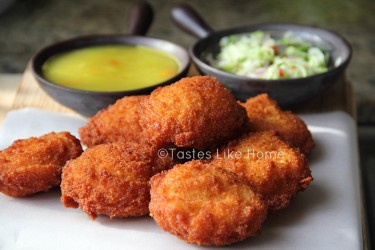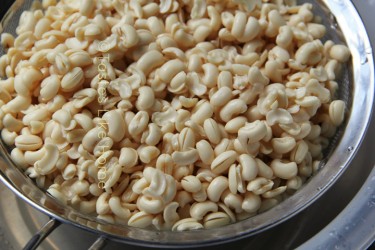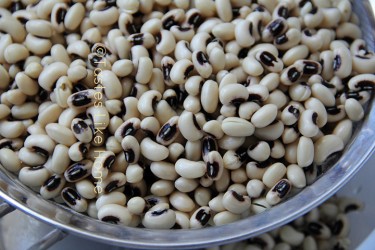Hi Everyone, Last week Wednesday, I sat for 4 straight hours engaged in the tedious task of removing the skins off of 4 ½ cups of rehydrated black eye peas. The constant dipping of my hands into the water left my fingers cold and wrinkled. I endured all of this because I wanted to make Acarajé – black-eye pea fritters – a popular street food in Brasil.
Acarajé (ah-CAR-ah-jeh) came to Brasil via West Africa where it is a well-known street food from Côte d’Ivoire to Nigeria, and is known by several names – Tosmo, Gawoo, Samsa and Akara. In the Bahia region of Brasil where Acarajé is popular, the fritter is cut opened and loaded up with a spicy sauce-like mixture of shrimp cooked in coconut milk. Sounds great doesn’t it?
 Motivated by the urge to eat something different, I planned the making of Acarajé from the night before by soaking the peas overnight. I was not under any illusion that removing the skins from the peas was going to be done quickly, but 4 hours? My Brasilian blog-friend confessed that it took her 2 hours, however, she neglected to tell me that she had help! At the end of the 3rd hour I wanted to give up but that is not me; I start something, I’m going to finish it. The first hour and a half I spent rubbing each pea between my thumb and index finger. Let me tell you my hand hurt really bad so I stopped and tried a different method. I drained some of the peas shaking off the excess liquid and spread the peas on a towel-textured kitchen cloth. I figured that the “roughness” of the fabric would easily remove the skins. It wasn’t really very effective. The dryness of the peas made the skins come off a little easier when I rubbed them between my thumb and index finger but the going was slow and, because there was still liquid beneath the skins, the method proved ineffective. The final 2 hours I decided to peel the skins off. I did this by first prying the skin away from the “eye” of the peas. Once the skin was torn there, removing the rest of the skin was easy; it just took time because I could only peel one pea at a time.
Motivated by the urge to eat something different, I planned the making of Acarajé from the night before by soaking the peas overnight. I was not under any illusion that removing the skins from the peas was going to be done quickly, but 4 hours? My Brasilian blog-friend confessed that it took her 2 hours, however, she neglected to tell me that she had help! At the end of the 3rd hour I wanted to give up but that is not me; I start something, I’m going to finish it. The first hour and a half I spent rubbing each pea between my thumb and index finger. Let me tell you my hand hurt really bad so I stopped and tried a different method. I drained some of the peas shaking off the excess liquid and spread the peas on a towel-textured kitchen cloth. I figured that the “roughness” of the fabric would easily remove the skins. It wasn’t really very effective. The dryness of the peas made the skins come off a little easier when I rubbed them between my thumb and index finger but the going was slow and, because there was still liquid beneath the skins, the method proved ineffective. The final 2 hours I decided to peel the skins off. I did this by first prying the skin away from the “eye” of the peas. Once the skin was torn there, removing the rest of the skin was easy; it just took time because I could only peel one pea at a time.
My curiosity about making the fritter had to do with the texture. What would the texture of the cooked peas be without the fibre of the skins? The fact that the fritters were seasoned and flavoured with dried shrimp had me salivating.
Once the skins were removed, the actual making of the fritters was very easy. The peas and aromatics were pureed in a food processor and fried.
Here’s what I found.

● The peas when pureed became foamy, frothy and swelled in volume. The batter was light and fluffy. To be honest, I wondered if it would disintegrate once added to the oil. It didn’t, the batter held well and cooked up crisp on the outside and tender on the inside.
● The texture inside was spongy.
● The flavour of the dried shrimp in the batter gave it a very good savoury flavour that made it possible to eat on its own but it is a whole lot better with some kind of savoury sauce such as sour, pepper sauce or a pickle.
● I ate and served my Acarajé with fresh mango sour I had made as well as a cucumber-red onion pickle.
● The Acarajé was well received. The dried shrimp played the role of a secret ingredient as some of the tasters kept saying that there is something in the fritter that they liked but they couldn’t put their “finger” on what it was.

One day, God-willing, I would like to eat the Acarajé with the coconut milk and shrimp sauce, perhaps when I do go to Brasil. What I can tell you is this – I am NEVER making this again, unless I have at least 2 other people assisting me in removing the skins from the black eye peas. Be warned then, if you are planning to attempt this recipe, get at least 2 other people to assist you with removing the skin of the peas. However, if you are the type of cook for whom prepping and cooking is a meditative event, then it is the perfect task for you.
Acarajé (Black-eye Pea Fritters)
Yield: 24 – 26
INGREDIENTS
● 1 lb. dried black eye peas rehydrated overnight
● ¾ cup boiling water
● Heaped ½ cup dried shrimp
● ¾ cup chopped onions
● 2 teaspoons chopped garlic
● Minced hot pepper to taste
● Salt to taste
● Oil for deep-frying

DIRECTIONS
1. Rinse the rehydrated peas until the water runs clear and remove the skin from the peas. Once the skins are removed, rinse the peas and drain well. Set aside.
2. Add the shrimp to a small bowl and cover with the boiling water. Let soak for 10 minutes to rehydrate; drain well.
3. Add the shrimp, onions, garlic and pepper to the bowl of a food processor and pulse until very fine.
4. Add the drained peas and puree. You will need to do this in 2 batches. Be sure to scrape down the sides of the bowl intermittently.
5. Transfer the mixture to a bowl, add salt to taste and beat the batter a few times with a wooden spoon or spatula, the batter should be foamy and fluffy. Taste the batter for seasoning (salt) and adjust if necessary.
6. Heat the oil in a deep pan (such as a karahi or wok) or a deep pot (on medium heat).
7. Working in batches, spoon the batter into the oil. Cook on 1 side for 2 – 3 minutes or until brown, flip and cook for another 2 minutes. Repeat until all the batter is used up.
8. Slice and serve hot with a pickle, pepper sauce, sour or saucy stew of shrimp and coconut milk.
Cynthia




